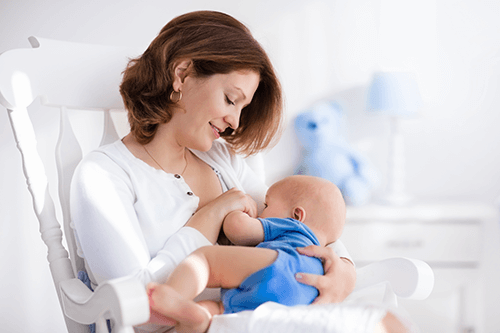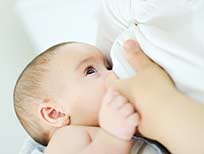BREASTFEEDING

We help new mothers understand breastfeeding to eliminate concerns and reduce unnecessary worry. New mothers often contemplate whether to breastfeed or bottle feed their new-born baby.
The following reasons outline why breastfeeding is best for both baby and mother.
BREASTFEEDING BENEFITS FOR BABY
- In the first year of a baby’s development, breast milk changes with each stage. The natural adaptation of breast milk triggers nutritional adjustments that produce the right amount of fat, sugar, water, protein, and minerals needed for the baby’s growth and development.
- Breast milk contains antibodies that protect infants from certain illnesses. The longer a baby breastfeeds, the greater the health benefits. Breastfeeding is beneficial for up to one year.
- It has been observed that breastfed infants have a lower risk of sudden infant death syndrome.
- Breast milk is easier for a baby to digest than formula.
- Breast milk can help reduce the risk of many of the long-term and short-term health problems that premature babies may face.
BREASTFEEDING BENEFITS FOR MOTHER
- When the baby nurses, it stimulates the release of a hormone called oxytocin that causes the uterus to contract. Contracting helps the uterus return to its normal size more quickly and may decrease the amount of bleeding experienced after birth.
- Breastfeeding may assist the mother to lose the weight gained during pregnancy.
- Breastfeeding may help reduce the risk of breast and ovarian cancer.
GETTING STARTED BREASTFEEDING
From the very beginning of a baby’s life, mothers should perform skin-to-skin contact immediately after delivery and throughout the first week of life. Holding the baby directly against the bare skin right after birth triggers reflexes that help the baby “latch on” to the mother’s breast.
- Cup the breast in the hand, stroke the baby’s lower lip with the nipple.
- Express a small amount of liquid onto the baby’s lip to stimulate more interest.
- When the baby opens his or her mouth wide, the mother pulls the baby close.
- Hold the baby to breast not breast to baby.
- Aim the nipple toward the roof of the baby’s mouth.
Breastfeeding should not be painful, with a proper latch. If the mother experiences pain with the baby’s latch, break the suction with a light finger in the corner the baby’s mouth and allow the baby to reattempt the latch.
BREASTFEEDING TIMELINE
 Most babies will feed at least 8-12 times in 24 hours and at least every 2-3 hours. They may breastfeed for at least 10-15 minutes on each breast and sometimes they will nurse longer. If a mother chooses to feed exclusively from one breast, alternate to the other breast on the next feeding.
Most babies will feed at least 8-12 times in 24 hours and at least every 2-3 hours. They may breastfeed for at least 10-15 minutes on each breast and sometimes they will nurse longer. If a mother chooses to feed exclusively from one breast, alternate to the other breast on the next feeding.
Mothers often wonder what the signs are when a baby is hungry and ready to breastfeed. A few signs include:
- The baby may become alert.
- The baby may bend their arms.
- Frequently the baby will bring their finger or fists to their mouths.
It is best to offer the breast when the baby looks alert or calm instead of waiting until they are crying. Crying is a late sign of hunger and babies become more frantic and have a harder time latching on when they are distressed. Once a baby is full, they will relax their arms and legs in contentment and may close their eyes.
If you have problems with breastfeeding, contact the lactation consultant at the location where you delivered your baby or your Rosemark provider.
NUTRITION DURING BREASTFEEDING
Mothers need extra calories and fluids each day so they can produce enough breast-milk for their baby. Consume approximately 2,500 total calories a day while breastfeeding. Rosemark providers may recommend that continual use of a prenatal multivitamin supplement while breastfeeding.
BREAST FEEDING TIPS
We are pleased to provide you with information about breast feeding which is the simplest, most loving gift a mother can give to her child.
HOLDS
There are many ways to hold your baby while breast feeding.
Cradle Hold
The first is the Cradle Hold. Support your baby’s head in the crook of your arm and hold him with his tummy against yours. Support your breast with your free hand. Because breast exposure is minimal, the cradle hold works well when nursing away from home.
Cross-Cradle Hold
Second is the Cross-Cradle Hold position. Hold your baby as you did for the cradle hold, but this time use the opposite arm so you are supporting his head with your hand and his body with your forearm. This hold gives you a little more control over his head.
Football Hold
Third is the Football Hold. For this hold, hold your baby alongside you. Support his back with your forearm and rest his head and neck in your hand. This is a good position if you’re recovering from a cesarean because it puts less pressure on the abdomen and the incision area.
Side-Lying Hold
Finally, the last hold would be the Side-Lying Hold. This is especially useful if you want to nurse while in bed. While you are in bed, lie on your side with your baby facing toward you. Support their head in the crook of your arm to keep their mouth level with your nipple. Place a pillow behind you for added support. This hold is a good choice following a c-section.
Latching On
Getting your baby to latch on correctly can often be difficult at first; but it will become easier with time.
To help your baby latch on correctly, first support your breast with one hand, placing your thumb on the top and your fingers underneath. This is called the C hold. With your nipple or your finger, gently stroke from the baby’s nose to his upper lip, causing him to open his mouth. Now, as your baby opens their mouth, move the baby closer to your breast until they latch on. When the baby is properly positioned, their lips should cover the nipple and a good portion of the areola.
Breaking the Suction
When your baby is finished nursing, break the suction by gently inserting your finger into the corner of their mouth and pulling toward the ear.
